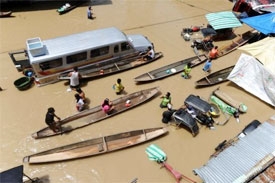Typhoon set to hit northern Philippines
 The eye of the typhoon was set to make landfall between 8:00 and 10:00 am (0000-0200 GMT), following roughly the same path as Typhoon Nesat, which ravaged the main island of Luzon on Tuesday, the state weather service said.
The eye of the typhoon was set to make landfall between 8:00 and 10:00 am (0000-0200 GMT), following roughly the same path as Typhoon Nesat, which ravaged the main island of Luzon on Tuesday, the state weather service said.
Luzon's north coast was being pounded by 75 kilometre (45 mile) an hour winds at dawn, forecaster Connie Rose Dadiva told AFP, but there were no immediate reports of casualties or damage.
Science Undersecretary Graciano Yumul warned residents to follow the advice of local officials to prevent more casualties, after Nesat killed at least 48 people and left 30 others missing, according to the latest official tally.
"They should monitor its track and follow the advice of local officials," he said, suggesting some of the victims of Nesat had failed to follow official guidance.
"They were properly warned, but they refused to evacuate," Yumul, who supervises the weather service, said in an interview aired over DZMM radio.
About 1.37 million out of Luzon's 48 million residents were still struggling with floodwaters on Saturday, the government's National Disaster Risk Management Council said.
About 142,000 of the flood victims are staying in state-run evacuation camps, with churches, schools and gymnasiums being cleared to take in more people who could be displaced by the approaching typhoon.
Nesat dumped the biggest single-day volume of rain on the disaster-weary Philippines this year, and Nalgae, with winds of 160 kilometres an hour, was expected to bring just as much over the same areas, the weather service said.
The capital, Manila, is on the edge of the new typhoon's 500-kilometre footprint.
Luzon and nearby islands are hit by an average of 20 major storms a year and those living in the flat farming plains usually prefer to sit out the strong winds and flooding in their homes rather than move to crowded evacuation camps.
What the stars mean:
★ Poor ★ ★ Promising ★★★ Good ★★★★ Very good ★★★★★ Exceptional
Latest News
More News
- Thailand seeks to promote digital training (November 04, 2024 | 16:14)
- Indonesia attracts foreign investment in technology sector (November 04, 2024 | 16:08)
- Tropical storm Trami leaves at least 24 people dead in Philippines (October 24, 2024 | 17:36)
- Singapore grants conditional approval for solar power import from Australia (October 24, 2024 | 17:27)
- ASEAN digital economy set to reach $2 trillion by 2030 (October 22, 2024 | 15:08)
- Thailand asks Laos to waive visa fee at border checkpoints to boost tourism (October 21, 2024 | 17:23)
- Laos pledges to continue efforts to empower girls (October 21, 2024 | 17:17)
- Chinese electric vehicle maker to build plant in Indonesia (October 21, 2024 | 17:12)
- Vietnam Elevator Association introduces Elevator Safety Application to the world (October 18, 2024 | 09:00)
- A taste of the future - the go-to spot at the Worldchefs Congress & Expo 2024 (October 15, 2024 | 16:11)



















 Mobile Version
Mobile Version